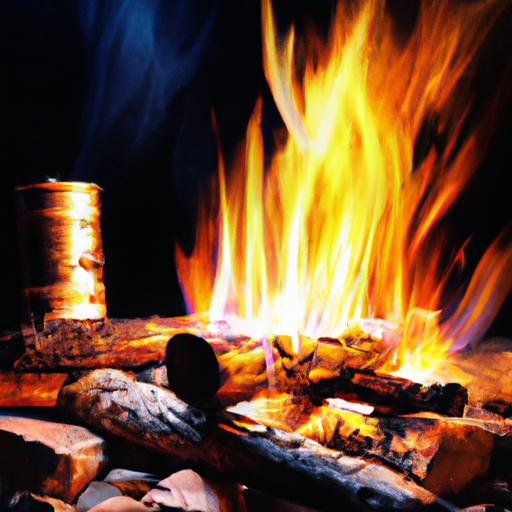In the vast realm of outdoor survival, knowledge is key. However, amidst the abundance of information available, it is easy to fall victim to the common myths that perpetuate throughout the community. In this article, we will explore some of these survival myths, uncovering the truth behind seemingly common beliefs. From the belief that moss only grows on the north side of trees to the notion that sucking venom out of a snake bite can save your life, join us as we debunk these myths and equip you with accurate knowledge for your next wilderness adventure.

Myth 1: Drinking Your Own Urine is a Viable Source of Hydration
When it comes to survival situations, you may find yourself in desperate need of water. It’s common knowledge that water is essential for our survival, but what if you’re stranded without any? This brings us to the first myth – the belief that drinking your own urine is a viable source of hydration.
Debunking the Myth
While it’s true that urine contains water, it also contains waste products that your body is trying to eliminate. Drinking urine can actually dehydrate you further, as your body will require more water to process and eliminate those waste products.
It’s important to note that urine is not sterile and can contain harmful bacteria and toxins. Consuming urine can lead to urinary tract infections and other health complications, which can be extremely dangerous, especially in survival situations where medical help may not be readily available.
Alternative Solutions
Instead of resorting to drinking urine, it’s crucial to prioritize finding clean water sources. Look for streams, springs, or natural water bodies, and if necessary, use purification methods such as boiling or using water purification tablets to ensure its safety.
Remember, staying hydrated is essential for survival, but there are much safer and reliable ways to obtain water than resorting to drinking your own urine.
Myth 2: Moss Always Grows on the North Side of Trees
One common survival myth passed down through generations is that moss always grows on the north side of trees. This belief has often been relied upon as a navigation technique when attempting to determine direction in the wilderness.
Debunking the Myth
While moss does tend to favor moist and shaded conditions, it does not necessarily grow exclusively on the north side of trees. Moss can be found on any side of a tree, depending on factors such as sunlight exposure, humidity levels, and wind patterns. Relying solely on moss growth for navigation can lead you astray and potentially put you in a dangerous situation.
Alternative Solutions
To accurately navigate your way in the wilderness, it’s important to rely on more reliable methods such as using a compass, learning to read the stars, or familiarizing yourself with natural landmarks. Survival training and carrying a map of the area can also greatly assist in ensuring you stay on the right track.
Remember, while it’s fascinating to observe moss growth, it’s not a foolproof method for finding your way in the wilderness.
Myth 3: You Can Suck Venom out of a Snakebite
Snakebites can be terrifying and potentially life-threatening, so it’s understandable that people seek immediate ways to mitigate the damage. One widespread myth is that if you’re bitten by a venomous snake, you can suck out the venom to prevent it from spreading.
Debunking the Myth
Sucking venom out of a snakebite is not only ineffective but can also be dangerous. Studies have shown that attempting to remove snake venom orally has little to no effect in preventing systemic absorption of the venom.
The act of sucking on a snakebite can actually introduce more bacteria and potentially damage the wound, leading to infections and further complications. It’s best to focus on seeking immediate medical help and keeping calm to slow the venom’s spread in your body.

Alternative Solutions
If you or someone you know is bitten by a venomous snake, it’s crucial to remain calm and seek professional medical assistance as soon as possible. While waiting for help, keep the bitten area immobilized, slightly below heart level, and clean to minimize the venom’s movement.
Always remember that snakebite treatment should be left to trained medical professionals who have the necessary antivenom and expertise to handle such situations.
Myth 4: You Should Rub Frostbitten Skin to Warm It
Frostbite occurs when your skin and underlying tissues freeze due to exposure to extreme cold temperatures. A persistent myth suggests that rubbing frostbitten skin can help warm it up and prevent further damage.
Debunking the Myth
Rubbing frostbitten skin can actually worsen the condition and cause additional harm. The friction generated by rubbing can damage the already fragile tissues and result in more extensive injury.
When dealing with frostbite, the affected area needs to be gently rewarmed using lukewarm water, between 104-108°F (40-42°C). Avoid using hot water, direct heat sources like fires, or vigorously rubbing the frostbitten area.
Alternative Solutions
If you’re experiencing frostbite, it’s crucial to seek medical attention immediately. While waiting for help, move to a warmer environment and remove any wet or tight clothing that may restrict blood flow. You can also lightly cover the affected area with a sterile, non-adhesive bandage or cloth.
Remember, prompt medical attention is crucial when dealing with frostbite to minimize the risk of long-term tissue damage or amputation.

Myth 5: You Can Outrun a Bear or Mountain Lion
Encountering large predators such as bears or mountain lions in the wilderness can be a terrifying experience. A common myth suggests that you can outrun these swift animals, leading people to think that they can escape harm by relying on their speed.
Debunking the Myth
The reality is that neither bears nor mountain lions can be outrun by humans. These animals are incredibly fast and can easily reach speeds of 35-40 miles per hour (56-64 kilometers per hour). Human sprinting speed rarely exceeds 15 miles per hour (24 kilometers per hour), even under optimal conditions.
Attempting to outrun a bear or mountain lion can trigger their predatory instincts and potentially lead to a dangerous pursuit. Instead, it’s crucial to take appropriate measures to reduce the risk of an attack and focus on safely backing away from the animal while maintaining eye contact.

Alternative Solutions
When encountering a bear or mountain lion, it’s essential to remain calm and avoid sudden movements. Back away slowly and try to make yourself appear larger by raising your arms or opening your jacket. Creating noise or using deterrents like bear spray can also help deter the animals without engaging in direct confrontation.
Remember, your best chance of survival lies in avoiding confrontation and properly following safety protocols when encountering large predators in the wilderness.
Myth 6: You Should Drink Alcohol to Stay Warm in Cold Environments
Surviving in cold environments requires careful attention to your body’s temperature regulation. An enduring myth suggests that consuming alcohol can help keep you warm in these conditions.
Debunking the Myth
Alcohol is a vasodilator, meaning it widens your blood vessels and can give the illusion of warmth. However, this process actually leads to increased heat loss from your body, putting you at a higher risk of hypothermia and cold-related injuries.
Drinking alcohol in cold environments can impair your judgment, dull your senses, and prevent you from recognizing the onset of hypothermia. It can also lead to dehydration, further exacerbating the risks associated with cold conditions.

Alternative Solutions
To stay warm in cold environments, it’s important to dress in layers and insulate yourself appropriately. Wear moisture-wicking materials and invest in high-quality, insulated clothing. Consuming warm fluids like tea or hot water can help maintain internal body temperature, but avoid relying solely on alcohol for warmth.
Remember, strategizing your clothing choices, staying dry, and seeking shelter in extreme cold can greatly improve your chances of survival.
Myth 7: Tilt Your Head Back to Stop a Nosebleed
Nosebleeds can occur due to a variety of reasons, including dry air, injuries, or underlying medical conditions. An age-old myth suggests that tilting your head back can help stop a nosebleed. Let’s explore the truth behind this common misconception.
Debunking the Myth
Tilting your head back during a nosebleed is not recommended, as it can potentially cause blood to flow down your throat, leading to nausea, choking, or even aspiration. It can also prolong the bleeding by hampering the blood’s natural clotting ability.
Instead of tilting your head back, it’s important to lean forward slightly and pinch your nostrils together, just below the bridge of your nose. This gentle pressure will help compress the blood vessels and promote clotting, ultimately stopping the nosebleed more effectively.
Alternative Solutions
If you experience a nosebleed, avoid blowing your nose or picking at any blood clots that may form. Apply a cold compress or ice pack to the bridge of your nose to reduce inflammation and promote vasoconstriction. If the bleeding persists for more than 20 minutes or is accompanied by severe pain or dizziness, seek medical attention.
Remember, adopting the correct stance and taking appropriate measures can help you effectively stop a nosebleed and prevent any further complications.
Myth 8: Sucking Venom from a Wound Can Be Done Safely
In movies and books, we often witness characters sucking venom from wounds caused by snakebites or insect stings. This portrayal has led to the common belief that sucking venom can be a safe and effective method of treatment.
Debunking the Myth
Attempting to suck venom from a wound is not only futile but can also lead to unintended harm. Venom spreads rapidly through your bloodstream, and once it enters your mouth, there is a risk of absorption through the mucous membranes.
Additionally, the act of sucking venom can introduce bacteria into the wound and potentially cause infections. It’s essential to leave venom extraction to medical professionals who have the appropriate equipment and expertise.
Alternative Solutions
If you or someone you know is bitten by a venomous snake or stung by an insect, seek medical attention immediately. While waiting for help, keep the affected area immobilized and slightly below heart level to reduce venom spread. Wash the wound gently with mild soap and water, and apply a sterile bandage if available.
Remember, rapid medical intervention, including antivenom administration, is the most effective treatment for venomous bites and stings.

Myth 9: You Can Start a Fire by Rubbing Two Sticks Together
Fire is an essential element in survival situations, providing warmth, a means of cooking, and a signal to potential rescuers. The idea that you can start a fire by rubbing two sticks together is a popular myth that has been perpetuated over time.
Debunking the Myth
While it is possible to start a fire by friction, rubbing two sticks together is an incredibly challenging method that requires precise technique, patience, and specific wood types. It can take hours of continuous and vigorous effort, making it an impractical method in most survival scenarios.
In reality, there are more reliable and efficient methods available for starting a fire, such as using matches, lighters, or carrying fire starters in your survival kit.
Alternative Solutions
To ensure you can start a fire in a survival situation, it’s best to have multiple fire-starting tools readily available. Carry waterproof matches, lighters, or fire starters in your kit. Additionally, familiarize yourself with alternative methods such as using flint and steel or magnifying lenses to ignite fires.
Remember, fire is a valuable survival tool, and having multiple reliable methods of starting one can greatly increase your chances of success.
Myth 10: You Should Play Dead when Approached by a Predator
Encountering a predator in the wild can be a terrifying experience, and instinctively, you may feel inclined to play dead in hopes of avoiding an attack. However, this often-touted survival myth may not always be the best course of action.
Debunking the Myth
Playing dead is a recommended technique for some predators, such as bears, but it’s not effective for all species. Predators have different instincts and behaviors, and playing dead can actually trigger them to view you as prey or encourage them to investigate further.
For instance, if you encounter a mountain lion, it’s better to maintain eye contact, make yourself appear larger, and back away slowly. Running away can trigger the animal’s instinct to chase. It’s crucial to research the specific behaviors and recommendations for the predators in your area to ensure appropriate actions are taken.
Alternative Solutions
When faced with a predator, educate yourself on their behavior patterns and survival recommendations specific to that species. Carry deterrents like bear spray or noise-making devices in regions where encounters with large predators are common. Always prioritize your safety and the safety of those around you by remaining calm, following expert advice, and avoiding direct confrontations whenever possible.
Remember, taking action based on accurate knowledge and understanding of predator behavior can greatly increase your chances of survival in the wilderness.
I’m Alex, the author behind True Survivalist. As a survival enthusiast myself, I’ve created this website to serve as a valuable resource for fellow survivalists and preppers. Whether it’s understanding survival situations, emergency preparedness, or finding the right survival gear, I’ve got you covered. Through a series of informative guides, I aim to provide answers to commonly asked questions, debunk common myths, and help you avoid common mistakes. At True Survivalist, I believe in equipping you with the knowledge and tools you need to be prepared for any survival scenario. Join me on this journey of self-reliance and resilience.

